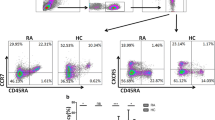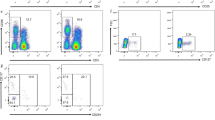Abstract
Follicular helper T(Tfh) cells and follicular regulatory T(Tfr) cells are critical for the development and maintenance of germinal center and humoral immune responses. Accumulating evidence has demonstrated that the dysregulation of either Tfh or Tfr cells contributes to the pathogenesis of autoimmune diseases. The aim of this study was to examine the numbers of Tfh and Tfr cells in patients with rheumatoid arthritis (RA). Twenty-four patients with RA patients and 20 health controls (HCs) were enrolled in this study. We analyzed the numbers of Tfh (CD4+ CXCR5+ PD-1hi) cells and Tfr (CD4+ CXCR5+CD127lo) cells in 24 RA patients via flow cytometry. The level of the soluble PD-1 and its ligands (sPD-L1 and sPDL-2) were examined by ELISA. Flow cytometry revealed that both circulating Tfh and Tfr cells were increased in RA patients compared with HCs. More importantly, the ratio of Tfr/Tfh was decreased, indicating a disruption of the balance between Tfh and Tfr. The Tfr/Tfh ratio was inversely correlated with level of serum CRP, ESR, RF, anti-CCP, IgG and DAS28 index. We also found that the serum level of sPD-1 was significantly elevated in the RA patients, which was positively correlated with CRP, ESR and the number of Tfh cells. These results indicate that an imbalance of circulating Tfr and Tfh cells may be involved in the immunopathogenesis of RA and may provide novel insight for the development of RA therapies.








Similar content being viewed by others
Abbreviations
- RA:
-
Rheumatoid arthritis
- cTfh:
-
Circulating follicular helper T
- cTfr:
-
Circulating follicular regulatory T
- GC:
-
Germinal center
- ELISA:
-
Enzyme‐linked immunosorbent assay
- CRP:
-
C-reaction protein
- ESR:
-
Erythrocyte sedimentation rate
- IgG:
-
Immunoglobulin G
- RF:
-
Rheumatoid factor
- CXCR5:
-
CXC chemokine receptor 5
- CCP:
-
Cyclic citrullinated peptide
- sPD-1:
-
Soluble PD-1
- sPD-L1:
-
Soluble PD-L1
- sPD-L2:
-
Soluble PD-L2
- DAS28:
-
Disease activity score in 28 joints
- DMARDs:
-
Disease-modifying antirheumatic drug
References
Firestein GS. Immunologic mechanisms in the pathogenesis of rheumatoid arthritis. J Clin Rheumatol. 2005;11(3 Suppl):S39–44.
Jutley G, Raza K, Buckley CD. New pathogenic insights into rheumatoid arthritis. Curr Opin Rheumatol. 2015;27(3):249–55. https://doi.org/10.1097/BOR.0000000000000174.
Angelotti F, Parma A, Cafaro G, Capecchi R, Alunno A, Puxeddu I. One year in review 2017: pathogenesis of rheumatoid arthritis. Clin Exp Rheumatol. 2017;35(3):368–78.
Craft JE. Follicular helper T cells in immunity and systemic autoimmunity. Nat Rev Rheumatol. 2012;8(6):337–47. https://doi.org/10.1038/nrrheum.2012.58.
Crotty S. Follicular helper CD4 T cells (TFH). Annu Rev Immunol. 2011;29:621–63. https://doi.org/10.1146/annurev-immunol-031210-101400.
Chung Y, Tanaka S, Chu F, Nurieva RI, Martinez GJ, Rawal S, et al. Follicular regulatory T cells expressing Foxp3 and Bcl-6 suppress germinal center reactions. Nat Med. 2011;17(8):983–8. https://doi.org/10.1038/nm.2426.
Park HJ, Kim DH, Lim SH, Kim WJ, Youn J, Choi YS, et al. Insights into the role of follicular helper T cells in autoimmunity. Immune Netw. 2014;14(1):21–9. https://doi.org/10.4110/in.2014.14.1.21.
Vanderleyden I, Linterman MA, Smith KG. Regulatory T cells and control of the germinal centre response. Arthritis Res therapy. 2014;16(5):471.
Zhu Y, Zou L, Liu YC. T follicular helper cells, T follicular regulatory cells and autoimmunity. Int Immunol. 2016;28(4):173–9. https://doi.org/10.1093/intimm/dxv079.
Sage PT, Sharpe AH. T follicular regulatory cells. Immunol Rev. 2016;271(1):246–59. https://doi.org/10.1111/imr.12411.
Vinuesa CG, Cook MC. Blood relatives of follicular helper T cells. Immunity. 2011;34(1):10–2. https://doi.org/10.1016/j.immuni.2011.01.006.
He J, Tsai LM, Leong YA, Hu X, Ma CS, Chevalier N, et al. Circulating precursor CCR7(lo)PD-1(hi) CXCR5(+) CD4(+) T cells indicate Tfh cell activity and promote antibody responses upon antigen reexposure. Immunity. 2013;39(4):770–81. https://doi.org/10.1016/j.immuni.2013.09.007.
Wei Y, Feng J, Hou Z, Wang XM, Yu D. Flow cytometric analysis of circulating follicular helper T (Tfh) and follicular regulatory T (Tfr) populations in human blood. Methods Mol Biol. 2015;1291:199–207. https://doi.org/10.1007/978-1-4939-2498-1_17.
Sage PT, Alvarez D, Godec J, von Andrian UH, Sharpe AH. Circulating T follicular regulatory and helper cells have memory-like properties. J Clin Invest. 2014;124(12):5191–204. https://doi.org/10.1172/JCI76861.
Xu B, Wang S, Zhou M, Huang Y, Fu R, Guo C, et al. The ratio of circulating follicular T helper cell to follicular T regulatory cell is correlated with disease activity in systemic lupus erythematosus. Clin Immunol. 2017;183:46–53. https://doi.org/10.1016/j.clim.2017.07.004.
Wen Y, Yang B, Lu J, Zhang J, Yang H, Li J. Imbalance of circulating CD4(+)CXCR5(+)FOXP3(+) Tfr-like cells and CD4(+)CXCR5(+)FOXP3(−) Tfh-like cells in myasthenia gravis. Neurosci Lett. 2016;630:176–82. https://doi.org/10.1016/j.neulet.2016.07.049.
Wang X, Zhu Y, Zhang M, Hou J, Wang H, Jiang Y, et al. The shifted balance between circulating follicular regulatory T cells and follicular helper T cells in patients with ulcerative colitis. Clin Sci (Lond). 2017;131(24):2933–45. https://doi.org/10.1042/CS20171258.
Zheng J, Wang T, Zhang L, Cui L. Dysregulation of Circulating Tfr/Tfh Ratio in primary biliary cholangitis. Scand J Immunol. 2017;86(6):452–61. https://doi.org/10.1111/sji.12616.
Arroyo-Villa I, Bautista-Caro MB, Balsa A, Aguado-Acin P, Bonilla-Hernan MG, Plasencia C, et al. Constitutively altered frequencies of circulating follicullar helper T cell counterparts and their subsets in rheumatoid arthritis. Arthritis Res Therapy. 2014;16(6):500. https://doi.org/10.1186/s13075-014-0500-6.
Wang J, Shan Y, Jiang Z, Feng J, Li C, Ma L, et al. High frequencies of activated B cells and T follicular helper cells are correlated with disease activity in patients with new-onset rheumatoid arthritis. Clin Exp Immunol. 2013;174(2):212–20. https://doi.org/10.1111/cei.12162.
Ma J, Zhu C, Ma B, Tian J, Baidoo SE, Mao C, et al. Increased frequency of circulating follicular helper T cells in patients with rheumatoid arthritis. Clin Dev Immunol. 2012;2012:827480. https://doi.org/10.1155/2012/827480.
Chakera A, Bennett SC, Morteau O, Bowness P, Luqmani RA, Cornall RJ. The phenotype of circulating follicular-helper T cells in patients with rheumatoid arthritis defines CD200 as a potential therapeutic target. Clin Dev Immunol. 2012;2012:948218. https://doi.org/10.1155/2012/948218.
Liu R, Wu Q, Su D, Che N, Chen H, Geng L, et al. A regulatory effect of IL-21 on T follicular helper-like cell and B cell in rheumatoid arthritis. Arthritis Res Therapy. 2012;14(6):R255. https://doi.org/10.1186/ar4100.
Aletaha D, Neogi T, Silman AJ, Funovits J, Felson DT, Bingham CO 3rd, et al. Rheumatoid arthritis classification criteria: an American College of Rheumatology/European league against rheumatism collaborative initiative. Arthritis Rheum. 2010;62(9):2569–81. https://doi.org/10.1002/art.27584.
Prevoo ML, van ‘t Hof MA, Kuper HH, van Leeuwen MA, van de Putte LB, van de Riel PL. Modified disease activity scores that include twenty-eight-joint counts. Development and validation in a prospective longitudinal study of patients with rheumatoid arthritis. Arthritis Rheum. 1995;38(1):44–8.
Simpson N, Gatenby PA, Wilson A, Malik S, Fulcher DA, Tangye SG, et al. Expansion of circulating T cells resembling follicular helper T cells is a fixed phenotype that identifies a subset of severe systemic lupus erythematosus. Arthritis Rheum. 2010;62(1):234–44. https://doi.org/10.1002/art.25032.
Good-Jacobson KL, Szumilas CG, Chen L, Sharpe AH, Tomayko MM, Shlomchik MJ. PD-1 regulates germinal center B cell survival and the formation and affinity of long-lived plasma cells. Nat Immunol. 2010;11(6):535–42. https://doi.org/10.1038/ni.1877.
Zhu C, Ma J, Liu Y, Tong J, Tian J, Chen J, et al. Increased frequency of follicular helper T cells in patients with autoimmune thyroid disease. J Clin Endocrinol Metab. 2012;97(3):943–50. https://doi.org/10.1210/jc.2011-2003.
Ma L, Zhao P, Jiang Z, Shan Y, Jiang Y. Imbalance of different types of CD4(+) forkhead box protein 3 (FoxP3)(+) T cells in patients with new-onset systemic lupus erythematosus. Clin Exp Immunol. 2013;174(3):345–55. https://doi.org/10.1111/cei.12189.
Sage PT, Francisco LM, Carman CV, Sharpe AH. The receptor PD-1 controls follicular regulatory T cells in the lymph nodes and blood. Nat Immunol. 2013;14(2):152–61. https://doi.org/10.1038/ni.2496.
Liu W, Putnam AL, Xu-Yu Z, Szot GL, Lee MR, Zhu S, et al. CD127 expression inversely correlates with FoxP3 and suppressive function of human CD4+ T reg cells. J Exp Med. 2006;203(7):1701–11. https://doi.org/10.1084/jem.20060772.
Linterman MA, Pierson W, Lee SK, Kallies A, Kawamoto S, Rayner TF, et al. Foxp3+ follicular regulatory T cells control the germinal center response. Nat Med. 2011;17(8):975–82. https://doi.org/10.1038/nm.2425.
Seddiki N, Santner-Nanan B, Martinson J, Zaunders J, Sasson S, Landay A, et al. Expression of interleukin (IL)-2 and IL-7 receptors discriminates between human regulatory and activated T cells. J Exp Med. 2006;203(7):1693–700. https://doi.org/10.1084/jem.20060468.
Hartigan-O’Connor DJ, Poon C, Sinclair E, McCune JM. Human CD4+ regulatory T cells express lower levels of the IL-7 receptor alpha chain (CD127), allowing consistent identification and sorting of live cells. J Immunol Methods. 2007;319(1–2):41–52. https://doi.org/10.1016/j.jim.2006.10.008.
Morita R, Schmitt N, Bentebibel SE, Ranganathan R, Bourdery L, Zurawski G, et al. Human blood CXCR5(+)CD4(+) T cells are counterparts of T follicular cells and contain specific subsets that differentially support antibody secretion. Immunity. 2011;34(1):108–21. https://doi.org/10.1016/j.immuni.2010.12.012.
Acknowledgements
This work was supported by the following grants: foundation from clinical medical research center of Shenyang City (18_009-4-03 to PT.Y.), foundation from the Major State Research Development Program of Liaoning, China (No. 2017225024 to PT.Y.), foundation from the Project for Construction of Major Discipline Platform in Universities of Liaoning province, China (2017001 to PT.Y.), the Program of the Distinguished Professor of Liaoning Province, Rheumatology (2017 to PT.Y.).
Author information
Authors and Affiliations
Corresponding author
Ethics declarations
Conflict of interest
The authors declare that they have no conflict of interest.
Ethical approval
The studies have been approved by the ethics committee of the first affiliated hospital of China Medical University. All procedures performed in studies involving human participants were in accordance with the ethical standards of the institutional research committee and with the 1964 Helsinki Declaration and its later amendments or comparable ethical standards.
Informed consent
Informed consent was obtained from all individual participants included in the study.
Rights and permissions
About this article
Cite this article
Wang, X., Yang, C., Xu, F. et al. Imbalance of circulating Tfr/Tfh ratio in patients with rheumatoid arthritis. Clin Exp Med 19, 55–64 (2019). https://doi.org/10.1007/s10238-018-0530-5
Received:
Accepted:
Published:
Issue Date:
DOI: https://doi.org/10.1007/s10238-018-0530-5




